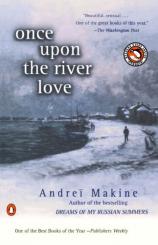Reading Group Guide
Discussion Questions
Once Upon the River Love

1. How does Mitya's initial story of a sexual encounter serve as an introduction to the novel and to the characters of Mitya and Utkin? How do you reinterpret the opening chapter when you discover at the conclusion that Mitya's tale is largely fabricated?
2.Topography and weather function as virtual characters in the novel, influencing thought, imagination, and action. How have the stark, harsh conditions of the Siberian taiga formed the boys and their way of life?
3.Enumerate the several images of burial and rebirth. What does each occasion signify?
4. Mitya speaks of leaving his body during the plunge in the snow after the bathhouse and again during his encounter with the "Redhead." Contrast the two episodes and the respective lessons gained by the disembodiments.
5.There is a tension between aesthetics and utility throughout the novel. If Belmondo is the ultimate example of art for art's sake, identify other manifestations of the aesthetic versus the utilitarian way of life. What are the respective merits and demerits of each mode?
6. Each of the three main characters seeks to transform their reality: Mitya through love, Utkin through the imagination, and Samurai through strength. Over the course of the novel, which way seems most successful in effecting this change?
7.Why is the story of the boys' magical year narrated by Mitya and not by Utkin, who is, after all, the Poet?
8.Does Mitya's late admission that his opening anecdote is substantially false throw doubt on other aspects of his story? Is he a reliable narrator?
9.Although Mitya always assumed that he was the only one to have contact with the "Redhead," he learns by the end that Samurai and Utkin have as well. How so, and how do each of the three respective encounters typify each of the three boys?
10. Explain the "Redheads"' reaction to Mitya when the lights suddenly come back on? Is there a recognition?
11. After Belmondo leaves the Red October Theater for good, Mitya proclaims, "Nothing would ever be as it had been before." In what ways did Belmondo alter individuals and society? In what ways did Belmondomania endure? What remained impervious to Belmondo's magic?
12. This retrospective tale is told by an older Mitya living out a compromised, perhaps debased, reality in the West. Would the novel have been as effective without this frame? How do the fates of the adult Mitya, Utkin, and Samurai inform the story of their adolescent Year of Belmondo?
Once Upon the River Love
- Publication Date: August 1, 1999
- Mass Market Paperback: 224 pages
- Publisher: Penguin (Non-Classics)
- ISBN-10: 0140283625
- ISBN-13: 9780140283624






